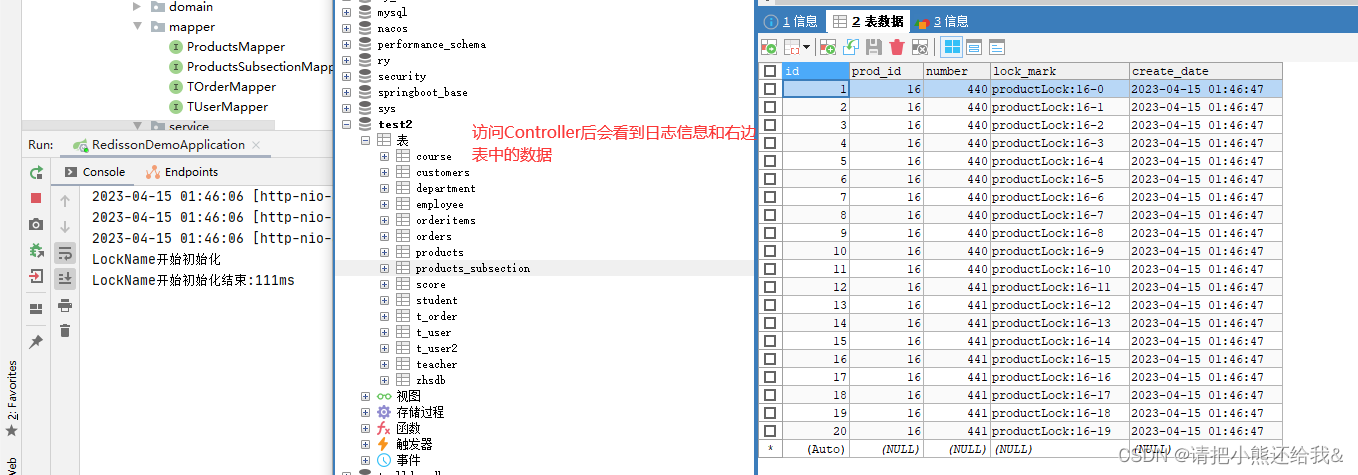我们先来看普通的加锁加事务秒杀性能,
说明:
1.这里的秒杀业务执行一次耗时100毫秒
2.电脑配置16g内存 4核8线程 cpu i7 7代,数据库连接池max=20
@RequestMapping("/purchase2")
public ResultJson purchase2( Long productId){
int userId = new Random().nextInt(10000);
UserInfo.setUserId(userId);
RLock lock = redissonClient.getLock("LOCK");
lock.lock();
OrderVO purchase = null;
try {
purchase = tOrderService.purchase2(productId);
if(purchase.isSuccess()){
return new ResultJson<>(200, "成功下单", purchase);
}else{
return new ResultJson<>(500, purchase.getMsg(), purchase);
}
} catch (Exception e) {
e.printStackTrace();
}
lock.unlock();
return new ResultJson<>(500, "下单失败", null);
}
100个商品 8000并发秒杀
1. 普通加锁加事务 100个商品8000并发,入库100条需要13秒,吞吐量一秒9次,这里jmeter只跑了2000个线程就停止了因为实在是太慢了不想等了


1000个商品,8000并发秒杀
1. 普通加锁加事务 1000个商品8000并发,入库1000条需要199秒这里jmeter只跑了2000个线程就停止了因为实在是太慢了不想等了


以下是我优化的方案,自定义了Seckill注解和ProductIdMark注解采用aop处理
@RequestMapping("/purchase")
@Seckill(tableName = "products", inventoryColumn = "prod_num" ,productIdColumn="id" )
public ResultJson purchase(@ProductIdMark Long productId){
OrderVO purchase = null;
try {
purchase = tOrderService.purchase(productId);
if(purchase.isSuccess()){
return new ResultJson<>(200, "成功下单", purchase);
}else{
return new ResultJson<>(500, purchase.getMsg(), purchase);
}
} catch (Exception e) {
e.printStackTrace();
}
return new ResultJson<>(500, "下单失败", null);
}100个商品 8000并发秒杀
1. 普通加锁加事务 100个商品8000并发,入库100条需要4秒,吞吐量一秒1034次


1000个商品 8000并发秒杀
1. 普通加锁加事务 1000个商品8000并发,入库1000条需要7秒,吞吐量一秒615次


分析
100商品优化前: 入库13秒,吞吐9/秒
100商品优化后: 入库4秒,吞吐1034/秒
1000商品优化前:入库199秒,吞吐9/秒
1000商品优化后:入库7秒,吞吐615/秒
可以看得出差别还是很大的
实现思路:所有请求被aop拦截,aop将用户存储到redis中,1000商品购买率是70%所以redis只要存储1500个用户的id即可,多余的直接返回商品售空,接下来轮到1500个用户竞争1000个商品,预热时候把1000个商品分成20份也就是每份50个商品,将20份商品存入库中作为lockName锁使用,同步轮训获取数据库中的lockName,获取到对应的lockName即可对该记录的库存进行扣减操作大致流程就是这样
下面是aop的主要实现:
@Aspect
@Configuration
public class SeckillAspect {
@Autowired
private RedissonClient redissonClient;
@Autowired
private ProductsSubsectionService productsSubsectionService;
@Pointcut("@annotation(seckill)")
public void pointCut(Seckill seckill) {
}
private final String infoKey= "info:productId:";
private final String indexKey= "index:productId:";
private final Long time=60*10L;
@Around("pointCut(seckill)")
public Object around(ProceedingJoinPoint joinPoint,Seckill seckill) throws Throwable {
String className = joinPoint.getTarget().getClass().getName();
String methodName = joinPoint.getSignature().getName();
String appName = className +":"+ methodName;
Long productId = getProductId(joinPoint);
//模拟用户
int userId = new Random().nextInt(100000);
UserInfo.setUserId(userId);
//初始化商品数据
init(appName,productId);
if(stopRun(appName,productId)){
return new ResultJson<>(500, "商品售空", null);
}
//防止同一个用户使用外挂疯狂点击
RMap<Integer, Integer> map = redissonClient.getMap(appName+":userClicks");
RLock lockClicks = redissonClient.getLock("LOCK:"+appName+":5");
try {
lockClicks.lock();
map.put(userId,map.get(userId)+1);
}finally {
lockClicks.unlock();
}
if(map.get(userId) > 1){
return new ResultJson<>(500, "请勿重复提交", null);
}
RLock lock = redissonClient.getLock("LOCK:"+appName+":2");
lock.lock();
if(isUpdatePrimaryTable(appName,productId)){
updatePrimaryTable(seckill,productId);
}
String lockName = getLockName(appName, productId);
RLock lock4 = redissonClient.getLock(lockName);
try {
lock4.lock();
lock.unlock();
ProductsSubsection productsSubsection = productsSubsectionService.queryByLockMark(lockName);
if(productsSubsection.getNumber()==0){
return new ResultJson<>(500, "商品售空", null);
}
Object proceed = joinPoint.proceed();
productsSubsection.setNumber(productsSubsection.getNumber()-1);
productsSubsectionService.update(productsSubsection);
return proceed;
}finally {
lock4.unlock();
}
}
private Long getProductId(ProceedingJoinPoint joinPoint){
Object[] args = joinPoint.getArgs();
MethodSignature signature = (MethodSignature) joinPoint.getSignature();
Method method = signature.getMethod();
//一维数组是注解位置,二维数组是注解个数
Annotation[][] parameterAnnotations = method.getParameterAnnotations();
Long productId=null;
boolean noProductId = true;
for (int i = 0; i < parameterAnnotations.length; i++) {
Annotation[] annotation = parameterAnnotations[i];
for (Annotation var : annotation) {
if (var.annotationType().equals(ProductIdMark.class)) {
productId= (Long) args[i];
noProductId = false;
break;
}
}
}
if(noProductId){
throw new RuntimeException("形参未指定注解:ProductId");
}
return productId;
}
private boolean init(String appName, Long productId){
if(!redissonClient.getMap(appName).isEmpty()){
//已初始化
return false;
}
RLock lock = redissonClient.getLock("LOCK:"+appName+":2");
try {
lock.lock();
if(redissonClient.getMap(appName).isEmpty()){
List<ProductsSubsection> list = productsSubsectionService.queryByProdId(productId);
int inventory =0 ;
LinkedHashSet<String> locks = new LinkedHashSet<>();
for (ProductsSubsection subsection : list) {
inventory+=subsection.getNumber();
locks.add(subsection.getLockMark());
}
CommodityInfo info = new CommodityInfo();
info.setLockNames(locks);
info.setInventory(inventory);
RMap<String, Object> map = redissonClient.getMap(appName);
map.expire(time, TimeUnit.SECONDS);
String key= infoKey+ productId;
String key2= indexKey+ productId;
map.put(key,info);
map.put(key2,0);
}
}finally {
lock.unlock();
}
return true;
}
//统计用户点击数
private Integer userClicks(String appName,int size){
RMap<Integer, Integer> user = redissonClient.getMap(appName+":userClicks");
user.expire(time, TimeUnit.SECONDS);
RLock lock = redissonClient.getLock("LOCK:"+appName+":3");
int userLength = user.size();
if(userLength >= size){
return user.size();
}
try {
lock.lock();
if(user.size() < size){
//初始化用户点击次数
int userId = UserInfo.getUserId();
Integer clicks = user.get(userId);
if( clicks == null){
user.put(userId,0);
}else{
user.put(userId,clicks+1);
}
}
} finally {
lock.unlock();
}
return user.size();
}
private boolean stopRun(String appName,Long productId){
RMap<String, Object> map = redissonClient.getMap(appName);
map.expire(time, TimeUnit.SECONDS);
CommodityInfo info = (CommodityInfo) map.get( infoKey+ productId);
double size = info.getProbability() * info.getInventory();
RMap<Integer, Integer> user = redissonClient.getMap(appName+":userClicks");
user.expire(time, TimeUnit.SECONDS);
if(userClicks(appName, (int) size) >= size && !user.containsKey(UserInfo.getUserId())){
return true;
}
return false;
}
private String getLockName(String appName,Long productId){
String key= infoKey+ productId;
String key2= indexKey+ productId;
RMap<Object, Object> map = redissonClient.getMap(appName);
map.expire(time, TimeUnit.SECONDS);
CommodityInfo info = (CommodityInfo) map.get(key);
Integer index = (Integer) map.get(key2);
List<String> lockNamesList = new ArrayList<>(info.getLockNames());
map.put(key2,index+1);
return lockNamesList.get(index % lockNamesList.size());
}
private boolean isUpdatePrimaryTable(String appName,Long productId){
String key= infoKey+ productId;
String key2= indexKey+ productId;
RMap<Object, Object> map = redissonClient.getMap(appName);
map.expire(time, TimeUnit.SECONDS);
CommodityInfo info = (CommodityInfo) map.get(key);
Integer index = (Integer) map.get(key2);
return index==info.getInventory();
}
//更新主表
private void updatePrimaryTable(Seckill seckill,Long productId){
// 获取注解的值
String tableName = seckill.tableName();
String inventoryColumn = seckill.inventoryColumn();
String productIdColumn = seckill.productIdColumn();
System.out.println("开始更新"+tableName+"主表数据");
productsSubsectionService.updatePrimaryTable(tableName,inventoryColumn,productIdColumn,productId);
}
}
项目地址:
通用所有秒杀业务,只要商品表中有库存,商品id即可
使用规则:
1.创建分段表
CREATE TABLE `products_subsection` (
`id` bigint(20) NOT NULL AUTO_INCREMENT,
`prod_id` bigint(20) DEFAULT NULL,
`number` int(11) DEFAULT NULL,
`lock_mark` varchar(20) DEFAULT NULL,
`create_date` datetime DEFAULT NULL,
PRIMARY KEY (`id`)
) ENGINE=InnoDB AUTO_INCREMENT=21 DEFAULT CHARSET=utf8mb4
2.在Controller的方法中使用Seckill注解和@ProductIdMark
//商品表名,库存字段名,商品id名
@Seckill(tableName = "products", inventoryColumn = "prod_num" ,productIdColumn="id" )
//用于表示商品id
@ProductIdMark访问后的效果

架构图






















 6923
6923

 被折叠的 条评论
为什么被折叠?
被折叠的 条评论
为什么被折叠?








